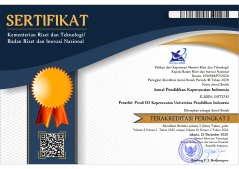The 7Ps Marketing Mix in Hospital Services: A Systematic Mapping of Applications Through a Scoping Review
Abstract
Background: The marketing mix is a vital framework for optimizing hospital services, improving patient satisfaction, and maintaining competitiveness in the healthcare sector. Despite its growing adoption, implementation remains inconsistent, with limited comprehensive reviews evaluating its overall effectiveness.
Objective: This scoping review explores the application of the marketing mix in hospital services, identifies key challenges and opportunities, and highlights research gaps to inform future healthcare marketing strategies.
Methods: A scoping review was conducted following Arksey and O’Malley’s framework and PRISMA-ScR guidelines. A systematic search across PubMed, Scopus, and Web of Science identified peer-reviewed studies published between 2019 and 2023. Studies focusing on the marketing mix in hospital services were included, while non-peer-reviewed and irrelevant articles were excluded. Data extraction analyzed the implementation of the 7Ps framework and its outcomes.
Results: Seven studies examined the marketing mix in hospitals, highlighting key findings. Hospitals differentiate through specialized services, pricing strategies influence affordability, and accessibility affects patient choices. Digital marketing enhances engagement, and expert professionals improve service quality, though workforce shortages pose challenges. Streamlined procedures and modern infrastructure enhance patient experience, but barriers like high service costs, geographic constraints, digital literacy gaps, and operational inefficiencies limit full implementation.
Conclusion: The marketing mix is essential for hospital services and patient satisfaction but faces challenges in accessibility, workforce management, and digital transformation. Future research should assess its long-term impact and develop tailored frameworks to enhance hospital marketing effectiveness
Keywords
Full Text:
PDFReferences
Abedi, G., Malekzadeh, R., Moosazadeh, M., Abedini, E., & Hasanpoor, E. (2019). Nurses’ perspectives on the impact of marketing mix elements (7Ps) on patients’ tendency to kind of hospital. Ethiopian Journal of Health Sciences, 29(2).
Arksey, H., & O’malley, L. (2005). Scoping studies: towards a methodological framework. International Journal of Social Research Methodology, 8(1), 19–32.
Berkowitz, E. N. (2021). Essentials of health care marketing. Jones & Bartlett Learning.
Binsar, F., Kartono, R., Bandur, A., & Kosasih, W. (2022). Digital Transformation of Information Fulfillment and Patient Engagement for Health Service Safety. Proceedings of the 4th International Conference on Management Science and Industrial Engineering, 229–236.
Braun, V., & Clarke, V. (2006). Using thematic analysis in psychology. Qualitative Research in Psychology, 3(2), 77–101.
Brittain, K., Taylor, J. Y., & Wu, C. Y. (2010). Family adaptability among urban African-American women with hypertension. The Journal for Nurse Practitioners, 6(10), 786–793.
Brown, R., & Oliver, T. (2021). The application of multiple intelligences theory in special education: Benefits and limitations. Journal of Special Education Research, 34(3), 195–210.
Budrevičiūtė, A., Kalėdienė, R., Paukštaitienė, R., Bagdonienė, L., Stankūnas, M., & Valius, L. (2021). The perspectives of patients with type 2 diabetes mellitus on marketing mix elements in primary health care: a quantitative study from Lithuania. Primary Health Care Research & Development, 22, e1.
Dagger, T. S., Sweeney, J. C., & Johnson, L. W. (2007). A hierarchical model of health service quality: scale development and investigation of an integrated model. Journal of Service Research, 10(2), 123–142.
Gutierrez, L., Olsen, R., & Martinez, F. (2021). Combined aerobic and resistance exercise in wound healing. Diabetes Therapy, 12(6), 745–756.
Kazemi, S., Tavousi, M., & Zarei, F. (2021). A mobile-based educational intervention on STI-related preventive behavior among Iranian women. Health Education Research, 36(2), 212–223. https://doi.org/10.1093/her/cyaa054.
Kotler, PKeller, K. (2016). Marketing management. Pearson.
Lee, H., Kim, E., & Park, H. (2020). Mindfulness-based stress reduction for pediatric oncology patients: A systematic review. Journal of Pediatric Oncology Nursing, 37(3), 173–181.
Lochab, R. (2021). Service Innovation Framework In Complex Healthcare System.
McCarthy, C. J., & Uppot, R. N. (2019). Advances in virtual and augmented reality—exploring the role in health-care education. Journal of Radiology Nursing, 38(2), 104–105.
McLeod, J., Anderson, T., & Brown, S. (2020). Redistribution of plantar pressure through foot exercises. Journal of Diabetic Complications, 34(7), 125–138.
Ng, S., Tan, W., & Lee, H. (2023). Social media and adolescent mental health: The importance of content moderation. Current Psychology, 42(1), 57–68.
Nnamezie, G. (2021). Cost Control and Profit Maximization: Case of St. Francis Medical Center (SFMC) Nnewi, Nigeria. Trident University International.
Patel, B., & Thind, A. (2020). Usability of mobile health apps for postoperative care: systematic review. JMIR Perioperative Medicine, 3(2), e19099.
Peters, M. D. J., Godfrey, C. M., Khalil, H., McInerney, P., Parker, D., & Soares, C. B. (2015). Guidance for conducting systematic scoping reviews. International Journal of Evidence-Based Healthcare, 13(3), 141–146.
Ravangard, R., Khodadad, A., & Bastani, P. (2020). How marketing mix (7Ps) affect the patients’ selection of a hospital: experience of a low-income country. Journal of the Egyptian Public Health Association, 95, 1–8.
Smith, J., Anderson, T., & Lee, R. (2020). A psychosocial approach to disaster preparedness: The influence of self-efficacy and social networks. Journal of Community Psychology, 48(4), Journal of Community Psychology.
Smith, M. C. (2019). Nursing theories and nursing practice. FA Davis.
Tricco, A. C., Lillie, E., Zarin, W., O’Brien, K. K., Colquhoun, H., Levac, D., Moher, D., Peters, M. D. J., Horsley, T., & Weeks, L. (2018). PRISMA extension for scoping reviews (PRISMA-ScR): checklist and explanation. Annals of Internal Medicine, 169(7), 467–473.
Wang, S.-W., Chiou, C.-C., Su, C.-H., Wu, C.-C., Tsai, S.-C., Lin, T.-K., & Hsu, C.-N. (2022). Measuring mobile phone application usability for anticoagulation from the perspective of patients, caregivers, and healthcare professionals. International Journal of Environmental Research and Public Health, 19(16), 10136.
Williams, T., & Anderson, C. (2021). Social media’s impact on adolescent sexual behaviors: A critical review. Adolescent Research Review, 6(4), 493–506.
Woo, S., & Choi, M. (2021). Medical service quality, patient satisfaction and intent to revisit: Case study of public hub hospitals in the Republic of Korea. PLoS One, 16(6), e0252241.
DOI: https://doi.org/10.17509/jpki.v11i1.82221
Refbacks
- There are currently no refbacks.
Jurnal Pendidikan Keperawatan Indonesia(JPKI) published by Indonesia University of Education. JPKI is licensed under a Creative Commons Attribution-ShareAlike 4.0 International License.
Office :
Nursing Department. FPOK UPI.
229, Dr. Setiabudhi Street. Bandung 40154
West Java , Indonesia
E-mail : jpki@upi.edu

_.png)
_.png)
_.png)











